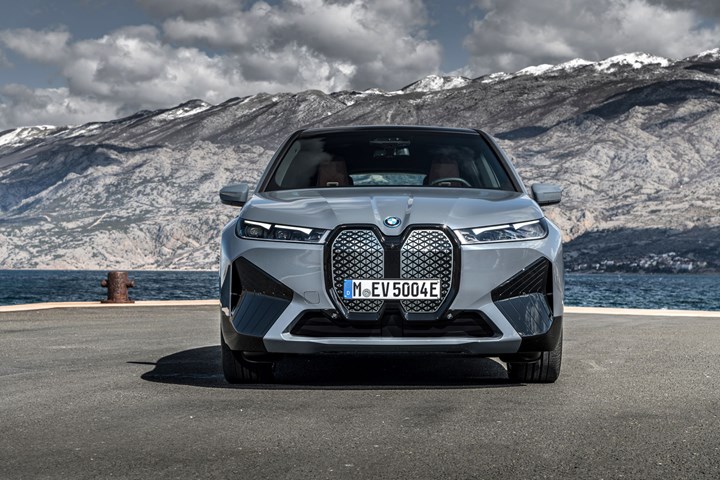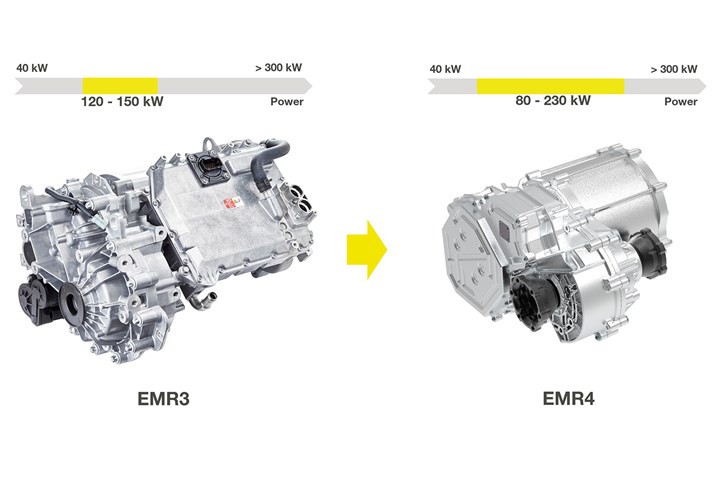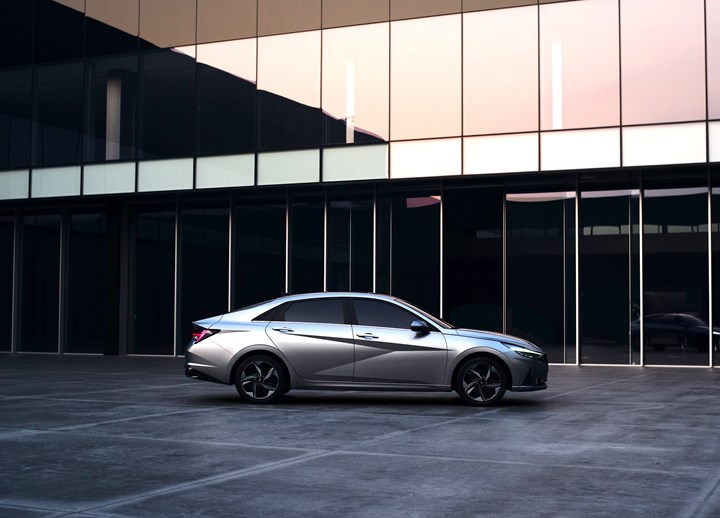On BMW Tech, VW Golf R Variant, Hyundai Elantra, and More
The forthcoming BMW flagship SUV—the 2022 iX xDrive50—has a lot of tech, some that is deliberately discrete. The Hawaiians spend a lot of money for gasoline and it would be less if they’d electrify. Euro drivers like wagons—and apparently extreme driving in them. Stellantis is spending big on going electric. And even more.
#electronics
“Shy Tech”

The BMW iX xDrive50 is a technological tour de force. What is interesting is some of the hidden tech deployed. (Image: BMW)
Although some might argue that the front grille of the forthcoming BMW iX xDrive50 is “in your face,” Don Smith, i Product Manager at BMW of North America, says that it is an example of some of the “shy tech” that is being used on the all-electric SUV that will become available in the U.S. early in 2022.
Shy?
He points out that the front-mounted radar is integrated into the grille, a not surprising thing.
But what is surprising is that there is a nanoscale, vacuum-based coating process used on the grille (vapor deposition is deployed) that results in a surface that is:
- Aesthetic (a two-color finish is applied)
- Functional (the thickness of the coating and the type of the material optimizes radar performance)
Yes, a nanoscale coating process leads to better sensor performance.
Another thing that you don’t necessarily see is that there is an additional polyurethane coating on the grille that is “self-healing.” Should there be a scratch, within hours the surface blends over it (quicker if something like a hair dryer is run over the surface).
Useful Badges
Of course there are the BMW roundel badges on both the front and rear fascias.
The front badge covers the opening for the windshield wiper reservoir. (After all, the iX iDrive50 is an electric vehicle, so its not like people are likely to go under the hood.)
The rear badge is even more shyly functional. There is a camera mounted within the black ring of the logo. Then to assure that visibility is maintained should the lens get dirty, a washer nozzle extends out from the center of the roundel and cleans the camera lens.
Shy Inside
Interior audio is another place where shy tech is being used.
In the available Bowers & Wilkins Diamond Surround Sound System eight speakers are integrated into the head rests for the first and second row seats. Bass shakers are located in the lumbar area of the front seats.
There are tweeters in the A-pillars, four 3D speakers in the headliner, two central bass speakers and two subwoofers under the rear seats.
Nothing shy about the audio output, however.
///
Getting to E

Vitesco is already on the fourth generation of its integrated electric axle drive. Note that improvements made from Gen 3. (Image: Vitesco)
“Electromobility is picking up speed. The key to supporting this megatrend lies in high efficiency and reliability as well as affordability for high-performing electric drive systems. We have anticipated this with the EMR4 design,” said Thomas Stierle, Executive Vice President Electrification Technology business unit, Vitesco Technologies, of the axle drive platform that the company unveiled at the 13th Transmission Symposium China, July 8.
Two points:
- The “4” in the name indicates this is the fourth generation of the Electronics Motor Reducer (which is where the letters for the EMR4 come from). Compared to the EMR3—which is being used in production vehicles (e.g., the Opel Corsa)—the 4 weighs 25% less at the same power level (power requirements from 80 to 230 kW are covered by the platform) while providing up to 5% increased efficiency for the axle drive. Lighter and more efficient.
- The integrated electric axle drive was designed so that all variants of the EMR4 can be produced on a single production line.
Consider. . .
As we saw last week in the item about the fast product development at Volta Trucks thanks, in part, to the use of a similar electric powertrain component from Meritor, the supplier industry is creating the equipment that OEMs are going to need for a more-rapid transformation to what can no longer be considered “an electrified future” because we are in the thick of it, right now.
///
A Serious VW Wagon

This VW wagon, which is available at VW outlets in Europe, will undoubtedly be used to make runs to the grocery store and to pick up the kids from school. But it can also do something else. (Image: VW)
This, as you can see, is a station wagon. In Europe the general term is “estate.” (Sometimes “shooting brake.”)
Specifically, it is the new Golf-R Estate.
Characteristic of a station wagon, it seats five and has from 21.5 to 58 cubic feet of cargo capacity (second row folded or not). It is available with a ball coupling that permits towing of 2,000 pounds.
The station wagon is powered by a 2.0-liter 316 hp four that produces 309 lb-ft of torque. It is mated to a seven-speed dual-clutch transmission.
Hooning on the Way to the Market
Here’s the thing that makes the Golf-R Estate undoubtedly unlike any station wagon you’re familiar with:
Those opting for the R Performance package get a total of six selectable driving modes, including “Drift.”
That’s right: a station wagon with the wherewithal to preform serious powerslides.
Maybe that’s why wagons are more popular in Europe than the U.S.
(Incidentally: a few issues back I mentioned how Genesis rapidly developed and launched the G70 Shooting Brake—a.k.a., station wagon—in Europe. Automotive News reported earlier this week that Genesis Europe boss Dominique Boesch anticipates that version will outsell the G70 Sedan in Europe. Euros like their estate/wagon/brake.)
///
Energy in Hawaii

Where the Hawaiian energy goes. (Image: EIA)
Looking at that chart, you may conclude that Hawaii has a somewhat disproportionate amount of vehicular fuel use, which is all the more problematic for those in the state given that the petroleum must be shipped in.
However, it turns out that the greatest amount of fuel used is not pumped into tourist rentals but pumped into the aircraft that get them there.
There are an estimated 100.5 trillion BTU of jet fuel used each year in Hawaii (EIA estimate, 2019 data), by far the biggest share of consumption.
Residential fuel follows at 63.5 trillion BTU.
Turns out that Hawaii has the highest average electricity retail price of any state because 60% of the electricity generated is based on burning petroleum.
Motor gasoline (excluding ethanol) is third, at 51.7 trillion BTU.
How Much Fuel Is Burned?
Research conducted by University of Hawaii at Manoa School of Ocean and Earth Science and Technology (SOEST) faculty member Katherine McKenzie has determined that in 2020 an average passenger EV consumed what is proportionate to 66 gallons of gasoline.
Gasoline-burning vehicles? 455 gallons.
The amount of CO2 produced by EVs is half that of ICE-powered vehicles.
As she writes in an article appearing in World Electric Vehicle Journal , “Based on 2020 data, the average passenger EV on Oahu used only 14% of the fossil fuel used by an average gasoline passenger vehicle. As a result, each passenger gasoline vehicle replaced with an EV reduced fossil fuel consumption by the equivalent of 389 gallons of gasoline in 2020.”
She Says
McKenzie: “Continuing to purchase anything powered by petroleum locks in emissions and energy insecurity for years to come, at a time when decarbonization is a climate imperative.”
///
The Stellantis $35.5-billion Transformation

Created in January 2021, Stellantis is the fourth-largest OEM in the world. (Image: Stellantis)
Carlos Tavares, CEO, Stellantis, says the global OEM is in the process of investing €30 billion--$35.5-billion U.S.—in electrification and software.
This is going to occur through 2025.
The company is aggressively developing what it refers to as LEVs—low-emission vehicles.
Full battery electric vehicles (BEVs) and plug-in hybrids are included in the LEV category.
Tavares expects that by 2030 Stellantis sales in Europe will be 70% LEVs. It will be more than 40% in the U.S.
Addressing Battery Costs
Cost, of course, is a big issue when it comes to LEVs.
So Stellantis is investing expertise (and Euros) in driving down the price of batteries. Tavares anticipates a battery pack cost reduction of more than 40% between 2020 and 2024 and another reduction of 20% by 2030.
It is pursuing two battery chemistries, one a high energy density battery and the other a nickel cobalt-free type.
It has signed memoranda of understanding (MOUs) with two lithium geothermal brine-process companies, in North America and Europe, to secure lithium for batteries.
Its battery sourcing strategy is to have access to 130-gigawatt hours (GWh) by 2025 and 260 GWh by 2030. This will be predicated on five battery gigafactories in Europe and North America, as well as additional supplier capacity.
Platform Approach
The company is developing four BEV platforms:
- STLA Small, with a range up to 300 miles
- STLA Medium, up to 440 miles
- STLA Large, up to 500 miles
- STLA Frame, also up to 500 miles
Then there are three electric drive modules, which include the motor, gearbox and inverter.
Part of the software spend will be on the in-house development of controls and software to meet the characteristics of each brands.
Whose Who
And speaking of each brand, they’ve all gotten their EV positionings pat:
- Abarth – “Heating Up People, But Not the Planet”
- Alfa Romeo – “From 2024, Alfa Becomes Alfa e-Romeo”
- Chrysler – “Clean Technology for a New Generation of Families”
- Citroën – “Citroën Electric: Well-Being for All!”
- Dodge – “Tear Up the Streets… Not the Planet”
- DS Automobiles – “The Art of Travel, Magnified”
- Fiat – “It’s Only Green When It’s Green for All”
- Jeep – “Zero Emission Freedom”
- Lancia – “The Most Elegant Way to Protect the Planet”
- Maserati – “The Best in Performance Luxury, Electrified”
- Opel/Vauxhall – “Green is the New Cool”
- Peugeot – “Turning Sustainable Mobility into Quality Time”
- Ram – “Built to Serve a Sustainable Planet”
- Commercial Vehicles – “The Global Leader in e-Commercial Vehicles”
Tavares is bullish about all this:
“We have the scale, the skills, the spirit and the sustainability to achieve double-digit adjusted operating income margins, lead the industry with benchmark efficiencies and deliver electrified vehicles that ignite passion.”
///
2021 Hyundai Elantra Limited

The Hyundai Elantra: Some companies reduce the amount of metal forming on body sides in order to reduce costs. Clearly there is an emphasis on style at Hyundai because there is plenty going on on that body. (Image: Hyundai)
One of the things that OEMs often boast about is the size of screens that are in their vehicles. There is, of course, the center screen, where things like audio and navigation are found, then there is the screen in the area where the gauge cluster is located.
For the Elantra, both are 10.25 inches in the Limited trim.
In many vehicles the gauge cluster space tends to have a digital version of an analogue speedometer and tachometer. There can be other things in that area, as well, like a tiny map.
There are a couple of things that are certainly small, overall, in the context of a motor vehicle but huge for living with the vehicle in that gauge cluster space.
The Elantra offers an available Qi charger for one’s phone (as well as wireless Apple CarPlay and Android Auto to help make use of said phone).
Should you have your phone in the charger and shut off the car, a message pops up on the screen that tells you the phone is still on the charger so you don’t forget it.
The other small thing: when you adjust the windshield wipers with the stalk there is a message indicating what setting you have selected. Critical? No. Nice? Yes.
Again, these things may be not given a second thought to—but what is encouraging about the execution in the Elantra is that it is clear that someone did think about these details.
If they think about the small ones, then you can have more confidence in the big ones, as well.
In fact, the overall interior is well executed, with the HVAC vents, for example, which stretch from just right of the steering wheel all the way to the far right side of the IP, seemingly the sort of thing that would be found in a class-above car.
==
And, of course, there’s the exterior.
I pulled into a Mobil station during the 4th of July holiday weekend and was followed in by a guy in a 1947 Mercury that appeared to be in mint condition.
“Is that an electric car?” he asked. I was driving an Elantra with the standard 2.0-liter, 147-hp four. There is also a hybrid version of the Elantra, as well as N Line higher performance versions.
I said it wasn’t.
“They sure make some nicely styled cars,” he responded.
Unsolicited comments like that aren’t common.
==
A vignette about the Elantra.
Back in the early ‘10s, John Krafcik was the CEO of Hyundai Motor America. (You probably recognize the name because of his stint a Waymo, where he was CEO until he left in April 2021.)
I have the honor of knowing John.
You may recall that model year 2011 was transformative for Hyundai as that model year included the redesigned Sonata, with its Fluidic Sculpture design language. That car changed everything for Hyundai in the market.
But I always thought that the execution on the Elantra, a compact, which came later to the Fluidic Sculpture party, looked better than the one on the midsize Sonata.
So John and I would go back and forth whenever the sales numbers came out—even after he departed Hyundai—about which car was doing better, with Krafcik supporting the Sonata and me the Elantra.
I checked the numbers for the first half of 2021.
Elantra: 74,057
Sonata: 54,198
Sorry, John.
==
One more thing.
The Elantra was named the 2021 North American Car of the Year.
Why does that matter?
Because 50 journalists (including me) drive a lot of vehicles every year. So for a car to be selected as the best from all those introduced during a given year is a solid accomplishment.
RELATED CONTENT
-
On The Jeep Grand Cherokee, 2022 Nissan Pathfinder, and More
An inside look at the Detroit Assembly Complex-Mack; a innovative approach to waste-free, two-tone painting; why a forging press is like an F1 car; and other automotive developments.
-
Honda to Make Hybrids in Thailand
Honda Motor Co. is preparing to launch production in Thailand of hybrid cars and the batteries that help power them.
-
on lots of electric trucks. . .Grand Highlander. . .atomically analyzing additive. . .geometric designs. . .Dodge Hornet. . .
EVs slowdown. . .Ram’s latest in electricity. . .the Grand Highlander is. . .additive at the atomic level. . .advanced—and retro—designs. . .the Dodge Hornet. . .Rimac in reverse. . .


.jpg;width=70;height=70;mode=crop)






